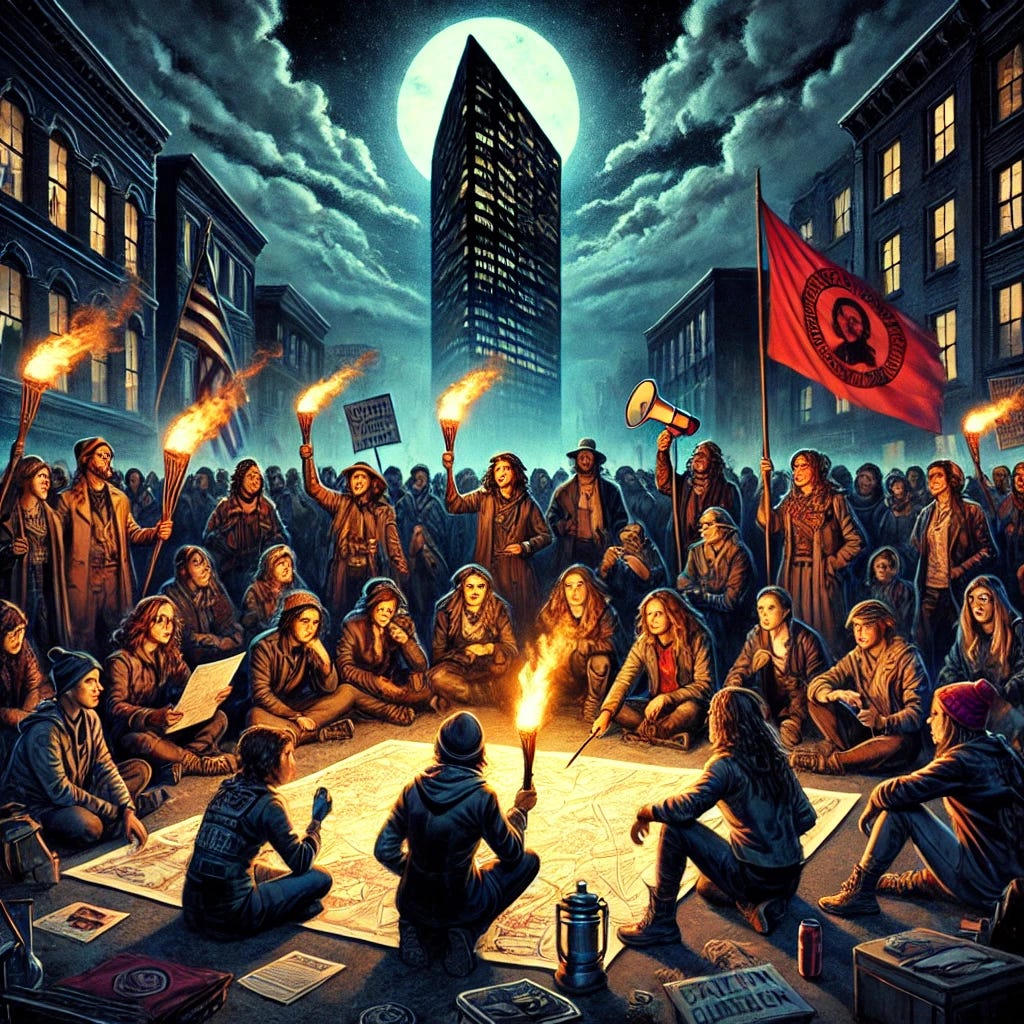Start Small and Scale - Organizing IS War.
Start where you are. Organize your workplace, your neighborhood, your city. No one wins alone, and no one changes history by just reading theory.
The Full Arsenal of Organizing Tactics: From Small Groups to Mass Movements
If you want to organize effectively, whether it’s a tight-knit cadre of committed activists or a mass movement capable of real political disruption, you need tactics that work at every level. Here’s the full tactical readout—everything from one-on-one recruitment to overthrowing the ruling class (hypothetically, of course).
1. FOUNDATIONS: BUILDING A MOVEMENT FROM THE GROUND UP
Before you even start organizing, you need three things:
A core mission (What’s the goal? Be specific.)
A leadership structure (Centralized or decentralized? How do you handle internal disputes?)
A recruitment strategy (Who are your people? Where are they? What do they need?)
Tactics at this stage:
✅ One-on-One Organizing – Talk to people. Get commitments. Build relationships.
✅ House Meetings – Small group discussions where people share grievances and build solidarity.
✅ Listening Sessions – Find out what issues actually move people before you tell them what to care about.
✅ Identify Natural Leaders – Your best organizers aren’t always the loudest. They’re the ones other people listen to. Find them.
2. SCALING UP: FROM SMALL GROUPS TO A MOVEMENT
Once you’ve got core members, you need to grow while staying organized. If you scale too fast without structure, you collapse. If you gatekeep too much, you stagnate.
Tactics for Growth:
✅ The "Snowflake Model" – Train organizers who train others. Decentralized leadership. No bottlenecks.
✅ Affinity Groups – Break large groups into smaller, trusted units that can operate independently.
✅ Collective Decision-Making – Consensus or democratic leadership models. Avoid "one charismatic leader" traps.
✅ Create Clear Onboarding Paths – If a new person shows up, what’s their next step? If they don’t know, you’ll lose them.
Structural Must-Haves:
✔ Organizing Principles – A short document with what your movement stands for.
✔ Code of Conduct – Keeps internal conflicts from blowing up and destroying everything.
✔ Security Culture – Who gets access to what? Don’t let the feds walk in the front door.
3. POWER-BUILDING: MAKING A MOVEMENT UNSTOPPABLE
Now you’re big enough to matter, but you need real power. This is where you shift from just “raising awareness” to forcing action.
Institutional Pressure Tactics (Working Within the System)
✅ Electoral Organizing – If taking political office is strategic, run people who actually represent the movement.
✅ Lobbying & Policy Writing – Force existing politicians to work for you (or expose them when they won’t).
✅ Strategic Alliances – Labor unions, community groups, progressive orgs. Strength in numbers.
✅ Mass Fundraising & Crowdsourcing – Money isn’t everything, but it helps. Be independent.
Direct Action Tactics (Escalation Outside the System)
✅ Strikes & Work Stoppages – Economic pressure is one of the most effective tools. If workers won’t work, capitalists can’t profit.
✅ Blockades & Occupations – Physically disrupt business as usual. (Think sit-ins, roadblocks, port shutdowns.)
✅ Boycotts – Target companies or industries where it hurts—their profits.
✅ Rent Strikes – Housing is a battlefield. Mass refusal to pay rent forces landlords to negotiate or collapse.
✅ General Strikes – The holy grail. Coordinated mass refusal to work. Requires serious preparation.
Media & Narrative Warfare
✅ Own the Narrative – Frame issues before your enemies do.
✅ Use Social Media Strategically – But don’t rely on it. Platforms will deplatform you if you’re too effective.
✅ Independent Media & Zines – Control your own message. Never trust corporate media to tell your story right.
✅ Meme Warfare – Information spreads faster when it’s funny and brutal. (See: Anti-capitalist TikTok.)
4. DEFENSE & CRISIS MANAGEMENT
A strong movement knows how to handle attacks, both external (state repression, police crackdowns) and internal (infighting, infiltration, burnout).
Countering State & Police Repression
✅ Legal Defense Teams – Always have lawyers on standby.
✅ Jail Support Networks – Never let arrested comrades fend for themselves.
✅ Encrypted Communications – Signal, ProtonMail, no WhatsApp, no Facebook DMs. Assume everything is surveilled.
✅ Know Your Rights Trainings – Teach people how to interact with cops (and when not to).
✅ Security Culture – Do not let strangers into organizing spaces without vetting. COINTELPRO never ended.
Internal Stability
✅ Conflict Resolution Committees – Internal disputes need structured mediation or they fester.
✅ Burnout Prevention – Don’t let leaders burn out. Rotate responsibilities.
✅ Beware of Ego-Driven Leadership – No one is bigger than the movement. If someone is hoarding power, check them.
5. TAKING OVER: LONG-TERM STRATEGY FOR REVOLUTIONARY CHANGE
If the goal isn’t just reform but a radical restructuring of society, here’s what movements in history have done when they got serious.
✅ Parallel Institutions – Start creating alternative systems before the collapse. (Think: community kitchens, people’s clinics, free schools.)
✅ Dual Power Structures – Create shadow governance that eventually replaces the existing system. (Example: Black Panther free breakfast programs were more effective than state welfare.)
✅ Defections from the State – Get insiders to flip (military, law enforcement, bureaucrats). A revolution only succeeds when the state starts losing control.
✅ Localized Self-Sufficiency – The fewer dependencies on capitalist supply chains, the more resilient a movement is.
✅ Seizing Control of Economic Infrastructure – Labor movements that control critical industries (energy, transport, food) can bring a system to its knees overnight.
Final Thought: Organizing is WAR
This is a strategic battle, and every movement that gets too powerful gets attacked. History is littered with state-sanctioned assassinations, COINTELPRO disruption, and outright massacres of leftist movements. If you don’t prepare for how to survive repression, you won’t survive at all.
Best Advice? Start where you are. Organize your workplace, your neighborhood, your city. No one wins alone, and no one changes history by just reading theory.


